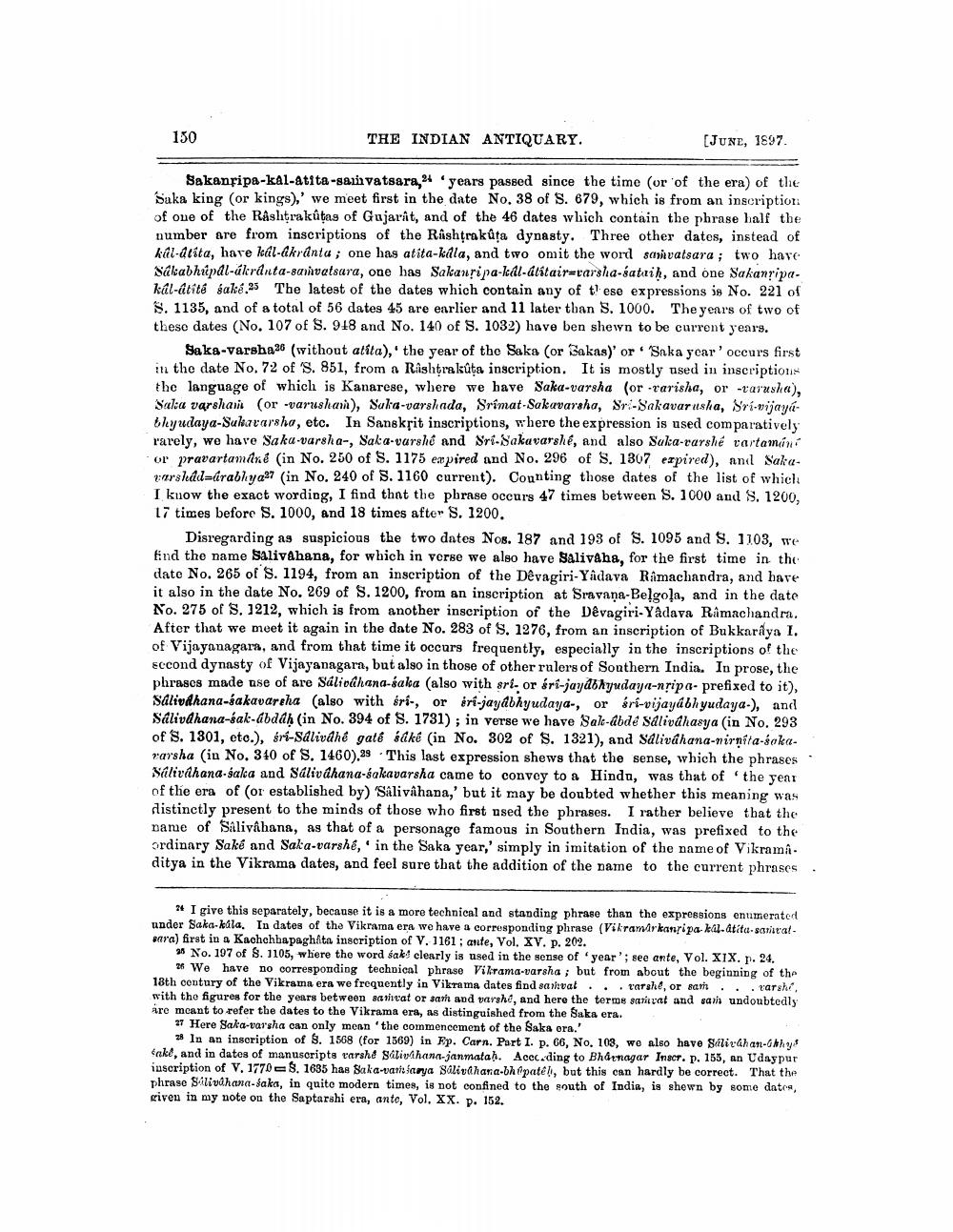________________
150
THE INDIAN ANTIQUARY.
[JUNE, 1897.
Sakansipa-kal-atita-sauvatsara, 24 years passed since the time (or of the era) of the Saka king (or kings),' we meet first in the date No. 38 of S. 679, which is from an inscription: of one of the Rashtrakûtag of Gujarat, and of the 46 dates which contain the phrase half the number are from inscriptions of the Rashtrakûța dynasty. Three other dates, instead of kál-atita, hare kál-akranta ; one has atita-kila, and two omit the word saivatsara; two have Sákabhipdl-úkranta-saivatsara, one has Sakansipa-kal-alitair=rarsha-satuih, and one Sakanripakál-átita saks.25 The latest of the dates which contain any of these expressions is No. 221 of S. 1135, and of a total of 56 dates 45 are earlier and 11 later than S. 1000. The years of two of these dates (No. 107 of S. 918 and No. 140 of S. 1032) have ben shewn to be current years.
Saka-varsha26 (without atita), the year of the Saka (or Bakas)' or 'Saka year' occurs first in the date No. 72 of 'S. 851, from a Rashtrakůta inscription. It is mostly used in inscriptions the language of which is Kanarese, where we have Saka-varsha (or-rarisha, or -tarasha), Saka varshani (or -varushan), Suka-varshada, Srimat-Sakavarsha, Sri-Sakavarusha, Srivijayabhyudaya-Suhavarsha, etc. In Sanskrit inscriptions, where the expression is used comparatively rarely, we have Saka-varsha-, Saka-vurshi and Sri-Sakavarshé, and also Suka-varshe rartamini or pravartamine (in No. 250 of S. 1175 expired and No. 296 of S. 1307 expired), and Sakavarshad=drabhya? (in No. 240 of S. 1160 current). Counting those dates of the list of which I kuow the exact wording, I find that the phrase occurs 47 times between S. 1000 and S. 1200, 17 times before S. 1000, and 18 times after S. 1200.
Disregarding as suspicious the two dates Nos. 187 and 193 of S. 1095 and S. 1103, te find the name Saliv&hana, for which in verse we also have Saliváha, for the first time in the date No. 265 of S. 1194, from an inscription of the Devagiri-Yadava Ramachandra, and have it also in the date No. 269 of S. 1200, from an inscription at Sravana-Belgola, and in the date No. 275 of S. 1212, which is from another inscription of the Dêvagiri-Yadava Ramachandra. After that we meet it again in the date No. 283 of S. 1276, from an inscription of Bukkarîya I. of Vijayanagara, and from that time it occurs frequently, especially in the inscriptions of the Eccond dynasty of Vijayanagara, but also in those of other rulers of Southern India. In prose, the phrases made use of are Sáliváhana-saka (also with sri- or éri-jaydbhyudaya-ntipa- prefixed to it), Sálivdhana-sakavareha (also with śr-, or éri-jayabhyudaya-, or éri-vijayabhyudaya-), and Sálivdhana-sak-abdah (in No. 394 of S. 1731); in verse we have Sale-abdé salivdhasya (in No. 293 of S. 1301, etc.), śrí-sdlivdhe gaté édké in No. 302 of S. 1321), and Sdliváhana-nirnita-sokavarsha (in No. 340 of S. 1460),29 This last expression shews that the sense, which the phrases Salivahana-salca and Salivahana-sakavarsha came to convey to a Hindu, was that of the year of the era of (or established by) 'Sálivihana,' but it may be doubted whether this meaning was distinctly present to the minds of those who first used the phrases. I rather believe that the name of Salivahana, as that of a personage famous in Southern India, was prefixed to the ordinary Saké and Saka-varshé,' in the Saka year,' simply in imitation of the name of Vikramaditya in the Vikrama dates, and feel sure that the addition of the name to the current phrases.
24 I give this separately, because it is a more technical and standing phrase than the expressions enumerated under Saka-kala. In dates of the Vikrama era we have a corresponding phrase (Vikramirkanripa kul.dtita-satıratsara) first in a Kachchhapaghita inscription of V. 1161; ante, Vol. XV. p. 202.
38 No. 107 of 8. 1105, where the word sakt clearly is used in the sense of year'; see ante, Vol. XIX. 1. 24.
26 We have no corresponding technical phrase Vikrama-varsha ; but from about the beginning of the 18th century of the Vikrama era we frequently in Vikrama dates find sarval ...rarshé, or sam ...rarshi, with the figures for the years between sariat or san and varshe, and here the terms sativat and saiha undoubtedly are meant to refer the dates to the Vikrama era, as distinguished from the Baka era.
27 Here Saka-varsha can only mean the commencement of the Baka ora.'
33 In an insoription of S. 1568 (for 1569) in Ep. Carn. Part I. p. 66, No. 103, we also have Silivahan-lahy akt, and in datos of manuscripts varahd Salivihana janmata. Acccding to Bhdunagar Inscr. p. 165, an Udaypur inscription of V. 1770 8. 1635 has Saka-varhlarya Salivahana-bhpatell, but this can hardly be correct. That the phrase Salivahana-Saka, in quite modern times, is not confined to the south of India, is shown by some data, given in my note on the Saptarshi era, ante, Vol. XX. p. 152.




